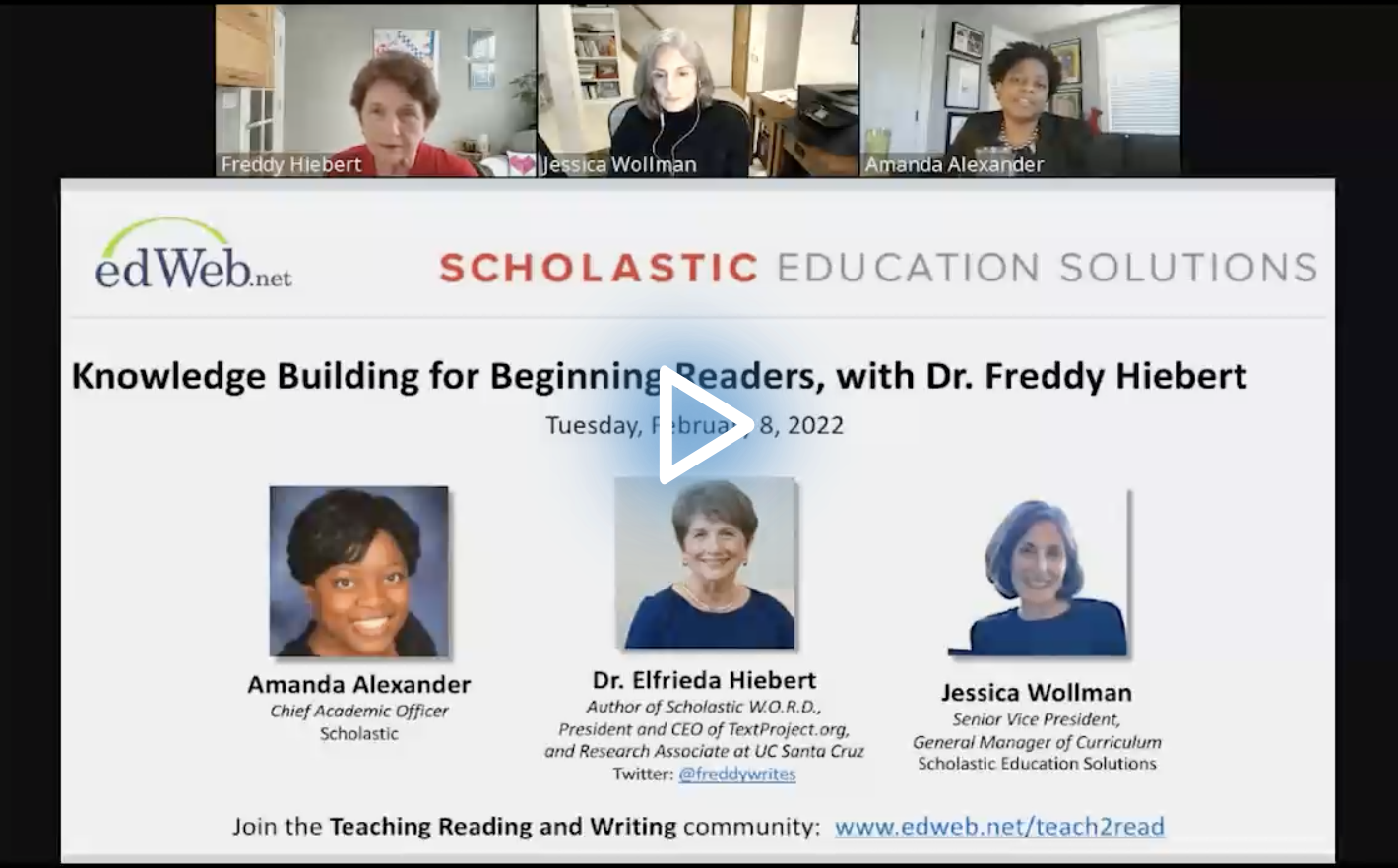Why Reading Is Not Just About Decoding
Blog post by Michele Israel based on this edLeader Panel
Readers may decode a word, but do they know what it means? Is the language in the texts they read compatible with what decodability dictates? And ultimately, does all that decoding make for reading comprehension?
Renowned reading researcher Dr. Freddy Hiebert contends that decoding alone is only one piece of the reading process. In the edLeader Panel, “Knowledge Building for Beginning Readers, with Dr. Freddy Hiebert,” she shared how to move beyond decoding to help students connect to books, understand text at a deeper level, and develop valuable knowledge along the way.
Nurturing Curiosity, Building Knowledge
Learners, especially young children, come to school with lots of curiosity. Some already know that books can be a significant source of knowledge, information, intimacy, and enjoyment that fulfill their interest.
But reading instruction doesn’t typically emphasize this critical role of books, explained Hiebert. Decoding generally jumpstarts children’s reading, yet letters alone don’t have meaning without contextual understanding.
As a part of the body of the Science of Reading research, psychologists Gough and Tunmer coined the phrase the Simple View of Reading to describe the role of decoding in the reading process. Reading comprehension, they concluded, is the product of decoding and language comprehension, without which a student is not thoroughly reading.
Decoding is Not Understanding
Decoding has foundational value but is not a reliable practice relevant to all texts, explained Hiebert. Moreover, even if decoding is somewhat successful earlier on, she added that its effect wanes over time.
A child might be able to decode and pronounce a word like “yak” (recognizing letter sounds and connections) but not know what a “yak” is! If they don’t know what the word is, urged Hiebert, not only are they unlikely to retain it, but they also won’t even be sure if they’ve decoded it correctly.
In early reading programs, decodables are usually centered on single and short, one-vowel words. But it is the long-vowel rimes that help learners recognize word families and the variability of letter-sound correspondence.
There is also an assumption that readers can readily transfer letter-sound correspondences to texts that might be similar in some ways, e.g. the same number of words but present different word patterns. However, Hiebert said evidence that such transfer can happen quickly is insufficient, especially if learners only see the words once with no other exemplars to guide them.
Generally, learning patterns takes a long time. The notion of once taught, then learned is not accurate, contended Hiebert, particularly when learners have not begun reading journeys that launch language recognition.
Patterns are also difficult to absorb, given the multiple sources and complexity of the English language. For example, think of sounds associated with the letter A: There is “sat,” but also, “said.” Likewise, there is “late,” and then, “load.” Those differences can be very confusing! And even more so because texts are so varied, making some of them more decodable than others. Hiebert explained that the complexity means the reading journey isn’t “automatic or a quick one” for children.
But even knowing patterns does not prepare young readers for the variability that appears across books, with some texts being more decodable than others.
Ways to Build Language and Comprehension
To fully appreciate the value of reading and develop their language skills, learners require ongoing connections to texts, explained Hiebert, drawing on the work of researcher Mark Seidenberg.
The latter underscores the critical link between text and language: “Readers become orthographic experts by absorbing a lot of data, which is one reason why the sheer amount and variety of texts that students read is important. And finally, we don’t study orthographic patterns to be able to read; we gain orthographic expertise by reading.”
Hiebert shared several strategies to do what Seidenberg recommends:
- Increase the volume of text: Reading more books that build knowledge from the get-go is essential to comprehension and word recognition.
- Engage learners in a topical resorting process to help learners who have limited text understanding learn from text. Students might read lots of beginning readers on cats, for example, enabling learners to align text in some book sets as they learn about cats from different perspectives, and doing things that children are likely to know about, like taking naps, sleeping, and sitting on laps. Learners are gaining knowledge as they make connections to letter-sound patterns.
- Use a variety of texts with words that are repeated across texts (within learners’ age of acquisition) and not in a single-word context to expose readers to patterns and word families. Hiebert recommended that children write the patterns they’ve learned on sticky notes or magnetic boards. She explained that writing is one of the most “critical dimensions in testing our hypotheses about letter-sound correspondence.”
- Read topical books aloud to children for a few days for at least a week, said Hiebert. Read alouds are especially beneficial to children with limited exposure to books; they invite them into an increased understanding of the specific topics.
- Document children’s learning. Create charts that record words they’ve learned, what they can read, and what they’ve read about.
The ultimate goal, concluded Hiebert, is to ensure students recognize early on that the books they read provide knowledge that contributes to a lifetime of language skills and reading comprehension.
Learn more about this edWeb broadcast, “Knowledge Building for Beginning Readers, with Dr. Freddy Hiebert,” sponsored by Scholastic Education Solutions.
Watch the Recording Listen to the Podcast
Join the Community
Teaching Reading and Writing is a free professional learning community on edWeb.net that provides a place where educators can collaborate on literacy instruction.
Scholastic Education Solutions provides teachers, families, and communities with the tools they need to support each and every child with print and technology-based learning programs for pre-K to grade 12, expert professional development, family and community engagement, and learning supports.





Comments are closed.